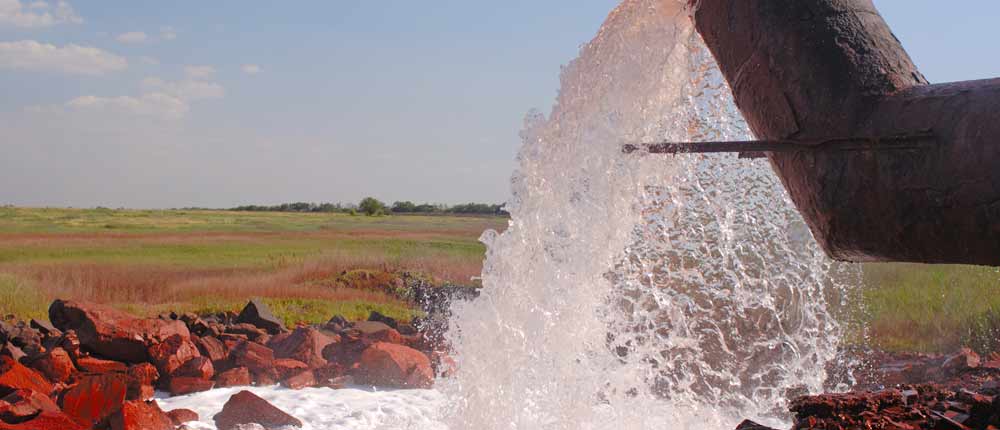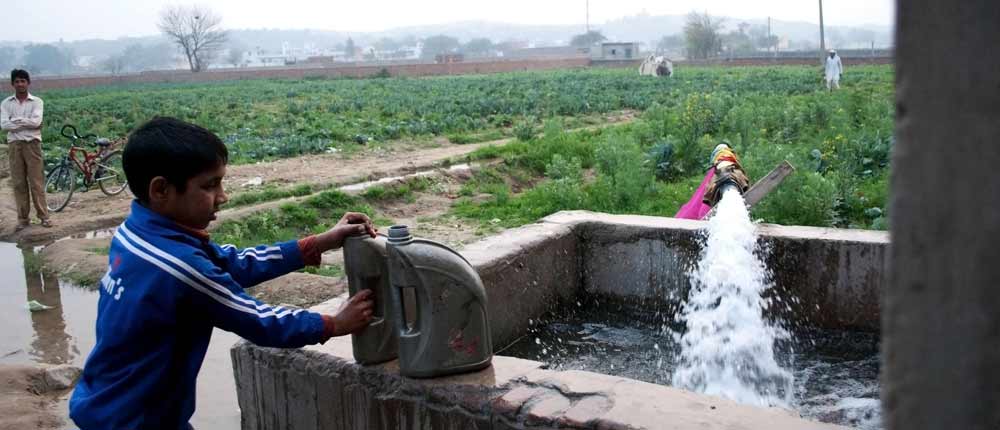In these times of agriculture crisis and falling water tables, it is important to rework policies to better address key challenges in the irrigation-power space

Food and water are deeply linked, and together with energy, have ensured continued existence of humans and ecosystems on Earth for millennia. There are several embedded intimate links within socio-ecological systems such as agricultural production systems that characterise the nexus between water, energy and food.
The nexus concept
Nexus thinking is born out of the idea that there are, in effect, 'no externalities'. An externality is the cost or benefit that affects a party that did not choose to incur it (Buchanan and Stubblebine 1962). Internalisation of the implications of and interactions with other life-supporting resources that had hitherto been externalised in policy and practice related to a particular resource is the essential challenge of the nexus. Taking forward from the Millennium Development Goals, the Sustainable Development Goals (SDGs) in 2015 underscore the global community's awakening to interdisciplinary solutions, sustainability and equity.
The idea of the food-water-energy nexus first gained attention in 1983 within the Food-Energy Nexus Programme at United Nations University. The programme examined food-energy challenges in developing countries, stressing on technology and policy solutions (Sachs and Silk 1990). The pursuit of environmentally sustainable economic growth puts immense stress on depleting natural resources in developing countries. This presents a more complex problem than industrialised nations as 'developed' countries by virtue of their stage of economic development undergo less rapid economic and population growth.
The Indian case
In India, the Green Revolution of the 1960s helped ensure food security for the starving millions. However, the economics of crop pricing and markets associated with the Green Revolution had damaging and far-reaching consequences on the country's water, energy and land resources.
Covering only 1.5 per cent of India's land, Punjab produces nearly 20 per cent of the country's wheat, 12 per cent of its rice and accounts for around 20 per cent of its pesticide consumption (Perveen et al 2012; Pepper 2008). Between 1971 and 2009, the area in the state irrigated by tube-wells increased by 85 per cent, while that irrigated by canals decreased by 14 per cent. This trend of excessive groundwater drafting for agriculture has led to water tables dropping at an alarming rate; 79 per cent of the groundwater assessment divisions (“blocks”) in the state are now considered 'overexploited' and 'critical' with extraction exceeding the supply (CGWB, 2010). Punjab is also grappling with the consequences of rampant use of chemical fertilisers and pesticides, water for irrigation, and power subsidies, in the form of drying up of aquifers, degraded soil quality, polluted groundwater and rivers, increased cases of cancer in farming communities, and a biodiversity that has disappeared. Integrated assessments accompanying a nexus approach thus come to fore as important tools of natural resource management and policy frameworks necessitating the need to understand these resources and their use embedded in broad political processes, economic structures and governance conundrums.

India, China and the USA are the world's largest irrigators, in that order (Sundquist 2007), and globally irrigation consumes the largest share of the world's freshwater. In India, groundwater irrigation has observed a marked rise since 1970s and water tables are depleting rapidly in many parts of the country. Schemes such as Minimum Support Price (MSP) and the Public Distribution System (PDS) have ensured a solid economic preference for rice and wheat based diets. This has led to a shift from traditional millets and the resultant increase in micronutrient deficiency. Studies have found that a favourable shift back to millets could ensure less water usage and thereby lower groundwater extraction, improve public health, and reduce greenhouse gas emissions. (Scott 2004; Rao et al 2018). Today, over 54 per cent of India's geographical area faces high to extremely high water stress (WRI 2015). However, tweaking the existing preference for rice and wheat using policy has remained elusive. Instead, due to the powerful lobby of large farmers and state irrigation departments, governments have continued to provide free or subsidised power to Indian farmers. This was cited as one of the major reasons why the northern and eastern grids tripped in 2012 and 2014 (Ganguly et al 2018). The state electricity boards require heavy subsidies to stay afloat and the political will to subvert the massive agriculture power subsidy is growing only slowly.
Groundwater irrigation is also highly energy intensive (IWMI 2009). A study addressed energy supply for groundwater pumping and advocated for establishing standards and norms of energy efficiency in pumps (Sant and Dixit 1996). Energy policy discussions in the Indian government have hitherto stressed on enhancing energy efficiency of electric irrigation pumps and given soft guidelines on increasing efficiency in energy use. The push for solar powered irrigation pumps in the 2018 Union budget is likely to ensure mechanisms to sell excess solar power from farmers back to the grid. While this may sound like a welcome change, the actual success of the policy lies in effective monitoring of the arrangement to ensure that price per unit of water sold from pumping groundwater using solar energy is lower than what the discoms are willing to pay per unit of energy (Shah 2018).

Going forward
Given the nature of competing developmental and environmental goals along with trends of rapid urbanization and population expansion in India, important questions arise: What is the rational amount and mix of food production to meet the demands of the growing population? Would aspirations for a food-secure future jeopardise water security? How can political attention be drawn to the need to better understand the nexus question? How can the present power distribution system better respond to falling groundwater tables, existing cropping patterns and climate change? What is the carbon footprint of groundwater overdraft for agriculture in the decades to come?
Despite its many implications, the nexus concept has been given inadequate attention in India's current policy frameworks. The design and implementation sides of national policy on farm incomes, food security, groundwater, energy and electricity have refrained from taking into account each other's experiences at the implementation level. Addressing these challenges would likely require a re-imagination of the agricultural sector with regards to water and energy policies in India.
The political economy of the nexus has unfortunately, adopted a perverse route and reversing it in the irrigation-power space is crucial given that the sector supports 56.66 per cent of India's total labour force, contributes 17 per cent to the GDP, uses 90 per cent of the country's total freshwater resources and consumes 17 per cent of its total power (Census of India 2011; Economic Survey of India 2016; World Bank 2016; CEA Statistics 2016). This requires enormous political will. Schemes announced in the recent budget to use solar energy for pumps and encourage use of barren land to set up decentralised solar power plants are thus a welcome step. Nexus thinking, however, is still at a nascent stage and operationalising policy recommendations requires much greater advocacy for effective policy changes.
References:
- Buchanan, J. & Stubblebine C. (November 1962). 'Externality', Economica 29 (116): 371–84 doi: 10.2307/2551386
- CGWB (Central Groundwater Board). 2010. State Profile. Groundwater Scenario for Punjab. Available at http://cgwb.gov.in/gw_profiles/St_Punjab.htm
- Ganguly A. R., Bhatia U. & Flynn S. E. Critical Infrastructures Resilience: Policy and Engineering Principles Routledge ISBN 9781498758635
- International Water Management Institute (IWMI). 2009. Strategic Analyses of the National
- Pepper D. (2008) 'The Toxic Consequences of the Green Revolution' US News. Retrieved 2018-06-14
- Perveen S. et al (2012) 'Restoring Groundwater in Punjab, India's Breadbasket: Finding Agricultural Solutions for Water Sustainability' Columbia Water Center, Earth Institute, Columbia University
- Rao ND, Min J, DeFries R, Ghosh-Jerath S, Valin H, Fanzo J (2018). Healthy, affordable and climate-friendly diets in India. Global Environmental Change 49: 154-165
- Sachs, I. & Silk, D. (1990). Food and energy: Strategies for sustainable development. vi, 83 p, ISBN: 92-808-0757-9.
- Sant, G. & Dixit, S. (1996). Beneficiaries of IPS subsidy and impact of tariff hike. Economic and Political Weekly, pp. 3315–3321.
- Scott, C.A. (2011). The water-energy-climate nexus: Resources and policy outlook for aquifers in Mexico. Water Resources Research 47, W00L04, 1–18.
- Shah, T. (2018) 'Deployment Approaches for Solar for Irrigation' Panel Discussion in National Dialogue on Solar for irrigation in India
- Shiao T. et al (2015) '3 Maps Explain India's Growing Water Risks' World Resource Institute Blog
- Sundquist, B. (2007) 'Irrigation overview' The earth's carrying capacity, Some related reviews and analysis. Retrieved 2018-02-02.

